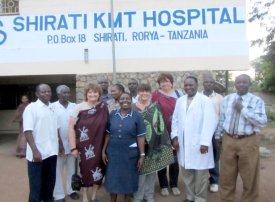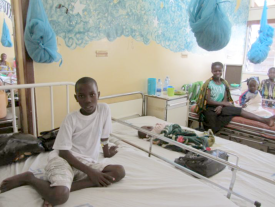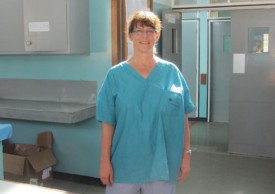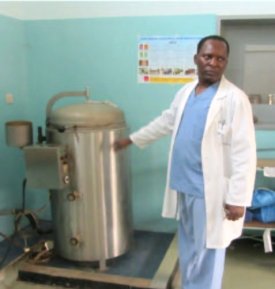From the moment that Medshare volunteers [in the Western Region] decided to raise the funds to ship a 40-foot container of medical supplies to Shirati, Tanzania, and I found out there was a possibility that volunteers could go to visit the hospital, I knew I wanted to be one of those volunteers. I actively participated in the fundraising for the container, contributing to the silent auction both in purchases and donations and also asking my friends and family for donations. And then my dream became reality as two other volunteers Fran Jurcso, Camille Harris, and I began our plans to travel to the hospital.
As we drove down the 18 miles of dirt road, four hours from the closest airport, we knew we were definitely in a very rural area. Dr. Chirangi welcomed us the day we arrived and took us on a tour of the hospital.

He pointed out all the equipment the hospital had received from Medshare in their previous shipment and excitedly showed us where all the new equipment would be going from the soon to be received container. Dr. Chirangi told us of all his immediate plans for additions to the hospital, and I realized what a difference receiving the supplies from Medshare would make to allow other money to go into the infrastructure of the hospital to meet more of their needs.
As we continued our tour and reached the different wards, I became very aware of the different experience one would have being hospitalized here rather than at home in the United States. There were simply four wards in the main hospital: men’, women, pediatric, and maternity. Each ward was simply one big room with barely an aisle to walk in between the beds.

There were no privacy curtains, patients were wearing their own clothes, visiting family members sat on the patients’ beds, and as the doctors examined incisions etc. the patient was exposed for all to see. Those recovering or waiting for surgery may be right next to someone with a contagious disease. The pediatric ward was so crowded we learned, that often they have to have two children per bed. Mosquito netting hung from the ceilings and the window openings had no glass in order to provide air circulation.
The highlight of the trip for me was when Dr. Chirangi invited us into the operating theatre to observe a surgery. After we put on our booties and masks (items I have sorted at MedShare) along with our scrubs we headed into the surgery room. It was early and the air conditioning had not yet been turned on.  We had heard many stories about the surgery room with the leaking anesthesia machine, which is why there was a new one on the shipment about to arrive.
We had heard many stories about the surgery room with the leaking anesthesia machine, which is why there was a new one on the shipment about to arrive.
What we didn’t realize was that we would experience what it was like to be in the room with the leaky anesthesia machine. Before completely embarrassing myself by fainting and giving them an additional patient, I simply left the room a bit green and went and got some fresh air. By the time the second surgery began, the air conditioning was on and I could handle it.

It was amazing to watch all the medical supplies I have sorted the last two years of volunteering in action and see first hand what a difference it makes: the bovies and tips, the gauze, the scalpels, the sutures, etc., etc. We watched Dr. Chirangi remove an ovarian cyst the size of a small avocado, repair an umbilical hernia, and remove an appendix all from the same patient in about 30 minutes. He even asked Fran to hand him the #4 Vicryl sutures, which of course she knew from her sorting experience.
The news of the container arriving soon, had reached the community and everyone knew who we were as soon as we said we volunteered at Medshare. While we were there we had time to explore the community a bit and found wherever we walked, we soon had children following us, walking with us, talking to us and holding our hands. Everyone in the community was so friendly and welcoming and it made us wish it could be like that back home rather than fearing strangers. The children loved having us take their pictures with our digital cameras and showing it to them, as at home they had no mirrors and didn’t know what they looked like. In fact on our walk from where we stayed to the hospital, (about a half mile) we passed houses that had no indoor plumbing, no electricity, and no running water. We saw how much of the community lives and how families work hard, simply to survive. We saw students walking miles to and from school each day, women walking miles to Lake Victoria to carry water home, (on their head), and we went to the market to see how they buy their food.
When we left for Shirati, we believed we were going to visit the hospital, but little did we know that we would fall in love with people of the community and want to continue to help them. This trip was an amazing opportunity to see firsthand what our efforts at Medshare do for the communities around the world. It showed us how important it is for us to let others know about Medshare whether they are possible volunteers, recipients, or teams that need supplies to take with them on medical missions.
“This trip was an amazing opportunity to see firsthand what our efforts at Medshare do for the communities around the world.”
At MedShare, we have listened to stories from doctors and nurses who return from similar areas after their medical missions. As amazing as their stories are, nothing was as incredible as us being there ourselves. Not having any medical experience, we felt privileged to have the opportunity to have this experience. If the opportunity is given to you, take it.
We would like to thank MedShare and all the volunteers who made this possible for us as well as AISCS (African Immigrants Social and Cultural Services) the NGO which funded the ground transportation for this container and also hosted us during our stay in Shirati.
Nancy Menne
Volunteer, MedShare’s Western Region Distribution Center
San Leandro, California
[Editor’s Note: The 40-foot container sponsored by the MedShare Western Region volunteers arrived at Shirati, Tanzania in early March 2014. Below are some of the photos of the container’s arrival at the hospital.

MedShare’s Western Region volunteers have just started their second fundraising project, this time for a shipment to Sierra Leone. You can read more about this project and make a donation here: http://medshare.donorpages.com/IshaSierraLeone/donatehere/.]

